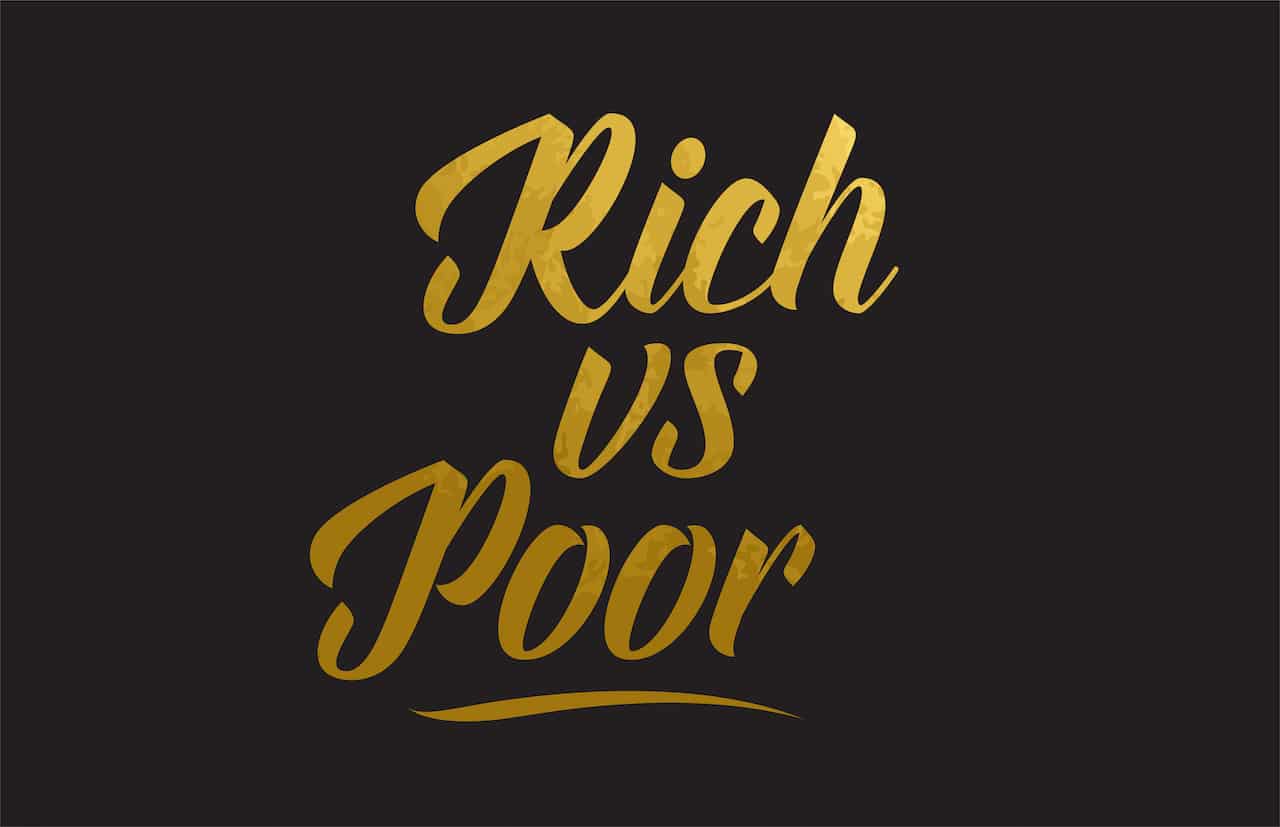Credit Sesame compares poor vs. rich households fared in the 2022 economy.
2022 was a strange year for the economy. The poor actually gained wealth last year while the rich got poorer. According to Federal Reserve data, the richest 0.1% of Americans lost about 8.1% of their wealth over the first three quarters of 2022. Meanwhile, half of the poorest households saw wealth increase by 18.9%.
Bear in mind the rich are still doing just fine. There is no need to start a GoFundMe page to bail them out. That top 0.1% still has over three times the wealth of the poor U.S. households that saw their wealth increase.
The reversal of fortunes for the rich illustrates the strange year that was 2022. How last year’s economy affected you depended a lot on your financial situation.
2022 was a brutal year for investors
The loss of wealth by the richest Americans in 2022 can be explained primarily by the fact that it was a rotten year for investments.
The Dow Jones Industrials Average declined by 8.8% in 2022. As bad as that is, that return was good enough to make it the star among U.S. stock indexes.
The S&P 500, which represents a broader cross-section of the stock market than the Dow, lost 19.4% last year. The Nasdaq composite, which is heavily influenced by tech stocks, did even worse. It declined by 33.1% in 2022.
Even traditionally safer investments offered little shelter in 2022. The Morningstar U.S. Core Bond Index lost 12.9% last year. That marked the worst year in the history of that index, which dates back to 1999.
Morningstar calculated that a broad 60/40 mix of stocks and bonds – a typical retirement portfolio allocation – would have had it’s worst year last year since the financial crisis of 2008.
While 2022 was a bad year for traditional investments, new age investors fared even worse. Bitcoin lost nearly two-thirds of its value last year. Meanwhile, the FTX debacle revealed a disturbing degree of instability in the crypto investing arena.
All of this had more of an impact on wealthier Americans. People with investments were likely to lose a significant chunk of their wealth last year. Poorer Americans, without the money to invest, were unaffected by the struggles of the financial markets.
Normally, of course, having investments helps the rich get richer. 2022 was an exception to the rule.
Inflation eased some debts but made others worse
Another way that last year’s environment helped some poorer Americans is that high inflation can actually reduce the value of some debt burdens. However, it depends greatly on the type of debt a person has.
Inflation basically shrinks the value of a dollar. A side-effect is that if you have a certain dollar amount of debt, the relative value of that debt goes down as prices generally rise.
The offset is that interest rates generally rise when inflation rises. That makes some kinds of debt harder to maintain.
Credit card debt, for example, rolls over frequently and so is quickest to be affected by rising interest rates. In contrast, people with fixed-rate loans like mortgages or car loans would see the relative value of those loans decline without an increase in their interest cost.
So, 2022 may have benefited some people with debt, as long as it was fixed-interest rate debt.
Poor vs. rich income vs. investments
The wealth of the rich is affected more by the performance of their investments than by their year-to-year earnings. The wealth of the poor who have accumulated fewer assets is dictated more by the size of their paychecks.
This may be another reason why poorer Americans actually gained more wealth last year than richer ones. While investments had a terrible year, it was a relatively good year for wage gains.
Based on data from the Bureau of Labor Statistics, Credit Sesame calculated that over the past ten years, hourly wages increased by an average of 3.2% per year. Last year, they increased by 4.6%.
So, 2022 was better for people whose finances primarily depend on employment earnings than those who depend more on investments.
Business owners were squeezed by high inflation and slow growth
Besides investors, business owners are another group of relatively wealthy Americans who had conditions working against them in 2022.
Inflation rose last year, while economic growth slowed. For business owners, that means rising costs and weaker sales. Conditions like that tend to but the squeeze on a company’s profits.
Poorer households had fewer options for avoiding inflation
One of the surprising things about the wealth increase among poorer Americans last year is that it outpaced inflation. This may be a fluke though because inflation generally hits poorer people especially hard.
A study by the Bureau of Labor Statistics found that poorer Americans generally experience higher rates of inflation than richer ones. That’s because less wealthy households have to spend more of their budgets on essentials. That gives them less flexibility to pick and choose which goods to buy based on prices.
While the household wealth of poorer Americans increased on paper last year, thanks to inflation their costs also rose. The longer inflation continues to be high, the more stress this is likely to put on poorer households.
Debt management should be especially important in 2023
To some extent, it may be too early to judge the impact of last year’s economic environment. A bad year for investors may simply mean they enjoy a bounce back in 2023.
Meanwhile, some people with debt may start to really pay the price this year. Both the amount of credit card debt outstanding and credit card rates rose to new highs in 2022. That means households with credit card debt are starting out this year facing a much higher cost for that debt.
Last year, the wealth of the poorest half of Americans grew faster than the wealth of the richest 0.1%. However, that hardly makes it easier on less wealthy households.
In particular, inflation continues to be a burden on people who are struggling to make ends meet. Their ability to stay ahead will depend greatly on how they manage their budgets and debt in 2023.
If you enjoyed How the poor vs. rich were affected by the economy in 2022 you may like,
Disclaimer: The article and information provided here is for informational purposes only and is not intended as a substitute for professional advice.




















